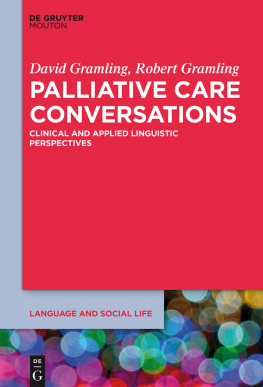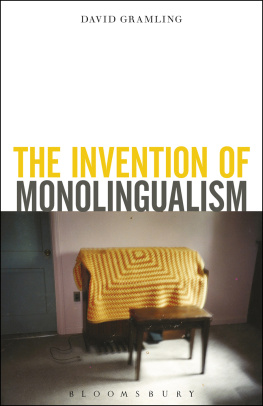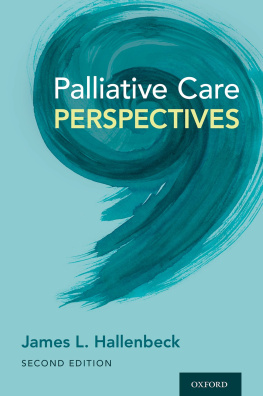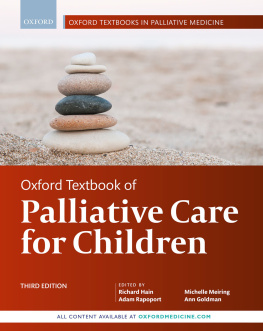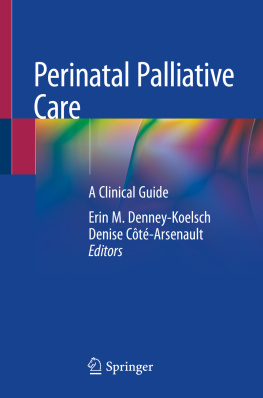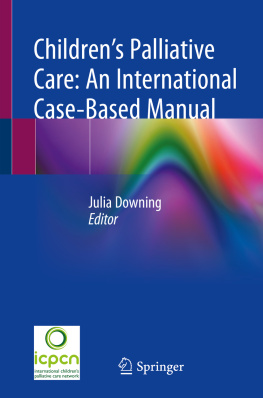Contents
Guide

David Gramling, Robert Gramling
Palliative Care Conversations
Language and Social Life

Editors
David Britain
Crispin Thurlow
Volume 12

ISBN 978-1-5015-1268-1
e-ISBN (PDF) 978-1-5015-0457-0
e-ISBN (EPUB) 978-1-5015-0447-1
ISSN 2192-2128
Library of Congress Control Number: 2018954425
Bibliographic information published by the Deutsche Nationalbibliothek
The Deutsche Nationalbibliothek lists this publication in the Deutsche Nationalbibliografie; detailed bibliographic data are available on the Internet at http://dnb.dnb.de.
2019 Walter de Gruyter, Inc., Boston/Berlin
www.degruyter.com
Acknowledgements
We thank the more than 250 patients and their family members who have agreed to share their experiences and perspectives with us for this study, as well as the more than 100 physicians, nurse practitioners, medical students, fellows, and residents whose work made this book possible. As co-authors, we are grateful for a brotherhood of patience, insight, critique, persistence, and willingness throughout the project across the boundaries of discipline, method, language, and vocational identity. There are many colleagues in Palliative Care and Applied Linguistics around the world from whom we have learned in the process of preparing this book; we are grateful to you. Institutions that propelled this project onward at various points, through financial or intangible contributions, include the American Cancer Society that funded the study from which our data arose (RSG PCSM124655; PI: R. Gramling), the University of Arizona Office of Research, Discovery, and Innovation, the Ohio State University Center for Folklore Studies, and the Holly and Bob Miller Chair in Palliative Medicine at the University of Vermont. Suruthi Managarone and her team at Integra Software Services provided excellent copy-editing support. This book is dedicated to our cherished family and friends who continue to guide us and our work with their love, wisdom, and lightness.
1Introduction
This book emerged out of the interactional work of hundreds of people talking with one another about living and dying in settings of serious illness. They are women and men, gay and straight, of color and white, Muslim, Christian, Jewish, Buddhist, Wicca, agnostic, and atheist, low-income and affluent, monolingual and multilingual, old and young. The questions and themes these speakers take up together range from the profound to the minute (see Bolden 2006, 2009, 2010) and they do so under conditions of great duress, suffering, struggle, and distraction (Alexander et al. 2014). The interactional work these people do, for and with one another, is the work of emotion, understanding, spirituality, empathy, morality, comfort, expertise, logistics, nourishment, community, care, knowledge, humor, doubt, and imagination (see Stivers et al. 2011).
But this work is always also the work of conversation itself, where a range of participants from physicians and nurse practitioners to medical students, family friends, and seriously-ill persons (Azoulay et al. 2000) co-create an unpredictable fabric of conversational speech acts among them, which help or thwart the accomplishment of certain interactional goals and meanings in certain moments (see Clift 2001; Ford and Thompson 1996; Goodwin and Duranti 1992; see also Costello and Roberts 2001; Fisher 1995; Waitzkin 1991; Frankel 1984; Nowak 2011). Sometimes the expression of these conversational goals may appear vague and diffuse to an observing companion or researcher; sometimes these are stunningly precise, urgent, and incontrovertible. At times, participants contributions to conversation refer to concrete clinical health realities; at other times, they have nothing to do with hospitals or illness whatsoever. Sometimes speakers goals coincide with one another; more often they do not or, at least, they diverge in consequential ways. On occasion, seriously-ill persons desires and identities are misconstrued, or go unacknowledged entirely. Often enough, though, the collective talk in the room succeeds in recognizing that Deep inside you, theres a part of you, the most inner part, thats entirely free from disease (Kushner 2013: 34).
1.1Conceptual groundwork
We titled this book Palliative Care Conversations in the plural, so as to emphasize our belief that there is no singular, exemplary conversational model that ought to be emulated in settings of serious, life-limiting illness contexts where multiple curative interventions have proven ineffective over time. There is no script, either for dying or for the time just preceding death. Of course, none of us even those who specialize in communicating about alleviating suffering in end-of-life contexts has done dying before ourselves. There are many such potential models for end-of-life conversation, and much of that exemplary plentitude comes forth in this book, thanks to the work of the patients, families, and clinicians featured in the ten chapters ahead. Forming the living core of this book are over 50 clinical conversations (selected from a much larger, multi-site set of audio-recorded consultations), which involve more than 150 patients, family members, Palliative Care clinicians, and clinicians from other specialties like oncology and neurology.
Because this book is meant to encourage exploration as much as it may also advance particular claims, we present as much of the interactional sequence of each selected conversation as is possible within the constraints of a 250-page print book. Whereas other studies may excerpt conversational data more sparsely, so as to articulate evidentiary support for a given thesis, we two authors understand ourselves within the occasion this book provides us as facilitating open and multidirectional dialogue among a broader general research community, one that decisively includes our current readers. We want these conversations to be discussed, appreciated, and rethought, and we hope that such broader engagement with them will help strengthen and clarify the value of Palliative Care, a field of health communication that is just now achieving sustained public awareness in the United States. In the spirit of collaborating with our readers, we have found it useful to represent these conversations in as much of their complex sequentiality, prosody, and social embeddedness as was possible (Curl et al. 2006; Local and Walker 2008; Couper-Kuhlen 2001), while honoring the anonymity and integrity of the contributing patients and clinicians. (For readers new to the kind of conversational transcription style used throughout this book, we recommend any of the helpful summaries of Jeffersons Transcript Notation system, particularly Atkinson and Heritage 1984: ixxvi). A short table of transcription symbols can be found at the close of this introduction.
Readers whether nurses, physicians, linguists, or otherwise may not have the time to read this book cover to cover. Of course, there are many resources available that model for clinicians best practices in health communication (Bernacki et al. 2014; Kurtz et al. 2004). There are also multiple handbooks on the market that survey applied linguistic and communication studies approaches to health and wellness (Hamilton and Chou 2016). This book was therefore conceived neither to reproduce those efforts, nor to replace them. What we have sought to do, instead, is to offer a random-access resource that allows clinicians and applied linguists the opportunity to drop into the arc of inquiry at various points, to benefit from what they can, and leave the rest until they next have an opportunity to do so. We offer no systematic theory, nor a totalizing set of tools and outcomes.

